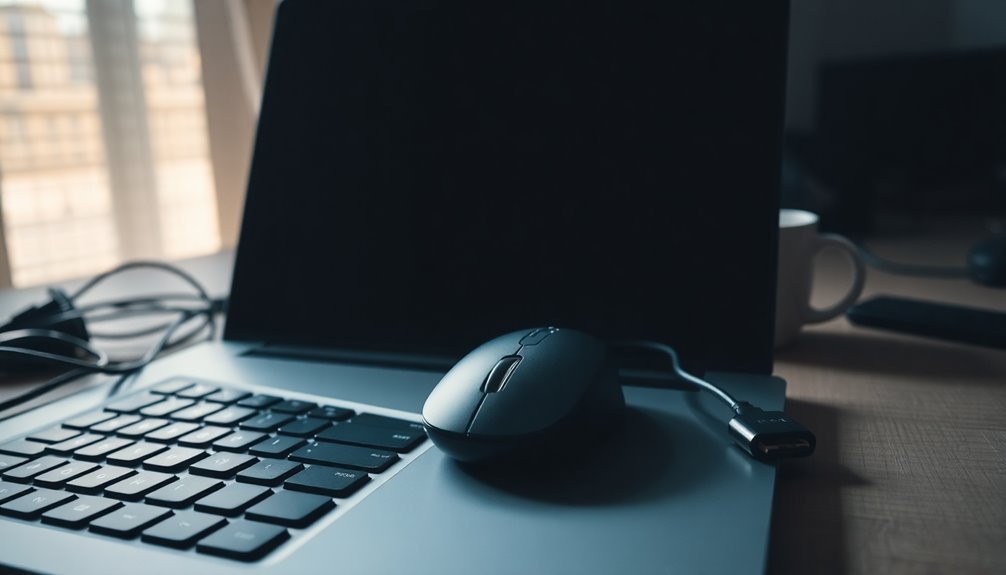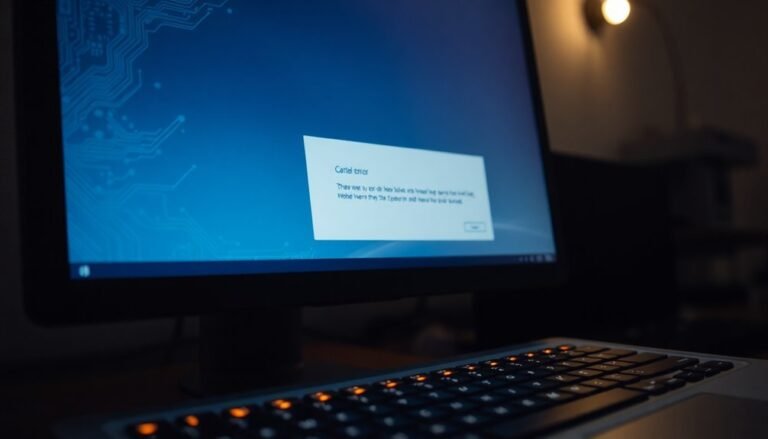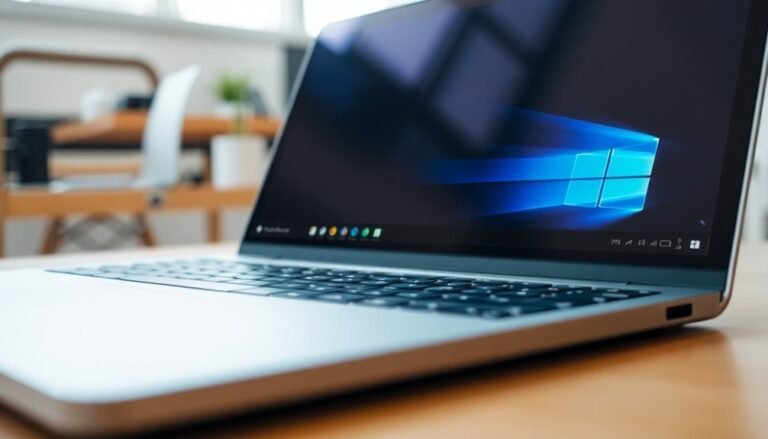Windows Operating System Not Working: Fix Fundamental System Problems

If your Windows operating system isn’t functioning properly, start by inspecting common problems such as low RAM, high disk usage, or outdated drivers. Boost performance by adjusting visual effects, managing startup processes, and ensuring your software is up to date.
You can use tools like System File Checker to repair corrupted files. Additionally, check for critical errors using Event Viewer.
Regularly utilizing System Restore can help safeguard your data from potential issues. There is much more to learn about resolving these problems effectively.
Common Causes of Unresponsive Applications

When applications become unresponsive, it’s crucial to understand the common causes to troubleshoot effectively. Insufficient system resources, such as low RAM and CPU overload, often lead to application freezes. Running multiple applications simultaneously or having heavy background processes can significantly strain your system. Additionally, high disk usage can hinder active applications, frequently resulting in “Not Responding” errors.
Outdated or incompatible software and drivers can also cause instability. Programs that aren’t compatible with the current Windows version, along with outdated drivers, may lead to application crashes. It’s important to ensure that your software and drivers are up to date to prevent these issues. Old or incompatible device drivers may often lead to further complications, exacerbating the problem.
Corrupted system files, which can occur due to improper shutdowns or hardware problems, may disrupt the functionality of programs. Repairing any damaged files is essential to maintaining system stability. Moreover, malware can hijack system resources and interfere with legitimate applications. Keeping your system clean from infections is key to restoring application responsiveness.
Steps to Enhance Device Performance
Enhancing overall device performance is crucial for a smooth and efficient computing experience, especially when dealing with unresponsive applications. To start optimizing your system, focus on adjusting visual effects through System Properties; either select “Adjust for best performance” or turn off specific non-essential effects. This simple change can free up valuable CPU and RAM resources.
Next, take control of startup and background processes by utilizing Task Manager. Disabling unnecessary programs not only shortens boot times but also minimizes resource usage, contributing to a more responsive experience. Regular updates help in fixing bugs and vulnerabilities, ensuring that your system runs smoothly.
Keeping your Windows operating system up-to-date is vital, so enable automatic updates and make sure to regularly update critical device drivers for optimal compatibility and performance.
Additionally, remember to uninstall any software you no longer use, and employ disk cleanup tools to maintain at least 10-15% of your disk space free.
To further enhance device efficiency, adjust your power settings by enabling Fast Startup and selecting High Performance plans. If your device is low on memory, consider using ReadyBoost to supplement RAM, which can lead to significant performance improvements.
Diagnosing and Fixing Frequent System Crashes
Frequent system crashes can severely affect your productivity. To effectively diagnose and fix these issues, begin by checking the Event Viewer, which logs critical errors and helps identify patterns related to your crashes.
Utilize Reliability Monitor to examine system stability over time and to recognize any recent changes that could be causing your system to destabilize.
One common culprit of system crashes is outdated or corrupted drivers. To address this, head over to Device Manager to ensure that all your drivers are updated and functioning properly.
If you suspect hardware problems, it’s wise to run diagnostic tools to assess the health of your RAM and monitor system temperatures.
Additionally, corrupt system files can lead to crashes. Use System File Checker (SFC) to scan for and repair these files.
If issues persist, consider performing a Startup Repair to address deeper problems. Running a malware scan with an up-to-date antivirus program is also crucial, as underlying threats can destabilize your system.
To minimize the chances of frequent crashes, regularly update your Windows operating system and all drivers, along with conducting timely maintenance checks.
Staying proactive in these areas can significantly enhance your system’s performance and prevent crashes from recurring. Keep your system running smoothly by following these essential tips for diagnosing and fixing system crashes.
Troubleshooting System Lockups and Heat Issues
How can you effectively troubleshoot system lockups and overheating issues? Start by evaluating your system’s RAM usage, as insufficient memory can lead to freezes and performance degradation.
Utilize tools like Task Manager to monitor resource consumption and terminate any unnecessary applications to free up memory.
Overheating is a common cause of system instability, so it’s crucial to inspect your cooling fans and heat sinks for dust accumulation. Regular cleaning helps maintain optimal airflow and cooling efficiency.
If your system temperatures are excessively high, consider upgrading aging fans or applying new thermal paste to the CPU for improved heat dissipation.
Adjusting your power settings can also lower the load on your CPU and GPU, which in turn reduces overall heat generation. If you suspect the possibility of malware affecting your system’s performance, run a reputable antivirus program to detect and eliminate infections that may be consuming resources.
Lastly, don’t forget to keep your BIOS updated, as updates can enhance thermal management and fan control capabilities.
Resolving Keyboard, Mouse, and Peripheral Non-Responsiveness

When experiencing keyboard, mouse, or peripheral non-responsiveness, conducting a hardware connection check is essential for quickly diagnosing the issue.
Start by ensuring that all cables are securely connected to the correct ports, as loose connections are a common culprit for problems. To further investigate, test your devices on a different computer to eliminate the possibility of hardware failure.
If you’re using USB hubs, it’s a good practice to remove them and connect directly to your PC’s USB ports to address potential power or data issues. Inspect cables for any visible damage and remember to check the batteries in wireless devices.
Next, keep your system up to date by updating drivers via Device Manager or directly from the manufacturer’s website. Don’t forget to look for available Windows Updates that might fix driver-related problems.
Utilize built-in troubleshooting tools, or test your keyboard and mouse functionality in BIOS/UEFI mode to diagnose further.
Lastly, verify that power management settings aren’t disabling your USB ports and consider minimizing interference from other Bluetooth devices to ensure a stable connection.
Repairing System File Corruption With Built-In Tools
After addressing issues with unresponsive peripherals, the next step is to repair any system file corruption that could be affecting your Windows performance.
Begin by utilizing the System File Checker (SFC) tool, which you can run easily by accessing Command Prompt as an administrator. Simply type `sfc /scannow` to initiate a scan that automatically detects and repairs corrupted system files.
Before executing SFC, it’s advisable to use the Deployment Image Servicing and Management (DISM) tool first. To do this, enter the command `DISM.exe /Online /Cleanup-image /Restorehealth` to help restore your Windows image effectively.
In cases where your system fails to boot, you can access the Command Prompt from recovery mode to execute these diagnostic tools offline. Use the command `sfc /scannow /offbootdir=d: /offwindir=d:\windows` to repair files directly.
Make sure to regularly check the logs located at `%Windir%\logs\cbs\cbs.log` for a detailed report of the repair process.
Utilizing both SFC and DISM is crucial for maintaining the overall integrity of your Windows system, ensuring it functions smoothly and efficiently.
Enabling System Restore for Effective Recovery
Enable System Restore for Optimal System Recovery****
To ensure that your computer can effectively recover from unexpected issues, it’s crucial to enable System Restore. Begin by accessing the Start menu on your Windows device and typing “Create a restore point” into the search bar. This action will direct you to the System Properties page, where you can configure your System Restore settings.
Next, locate the system drive listed under “Protection Settings” and click the “Configure” button. To activate system protection, select the “Turn on system protection” radio button. You can adjust the disk space slider according to your preference. After making your adjustments, click “Apply” and then “OK” to save your settings.
Once activated, System Restore will automatically create restore points during significant changes, such as software updates. It’s important to periodically check that System Restore is enabled.
You can also create manual restore points by clicking “Create” and naming each restore point for easy reference. This process secures your system files without impacting your personal data, giving you reliable options if you need to recover your system in the future.
Frequently Asked Questions
How Can I Backup My Files Before Troubleshooting Problems?
You can back up your files by using Windows Backup to save data to OneDrive, File History for external drives, or creating restore points. Confirm backups are verified and diverse to protect against data loss efficiently.
What Should I Do if I Forget My Windows Password?
If you forget your Windows password, use the “Forgot Password” option for Microsoft accounts, answer security questions for local accounts, or utilize a password reset disk. Consider third-party tools if those options aren’t viable.
How Can I Refresh or Reinstall Windows Without Losing Data?
When you’re in a pickle, use the “Reset this PC” option with “Keep my files.” This way, you can refresh Windows while keeping your personal data intact, but you’ll need to reinstall any removed apps.
What Are the Signs of a Failing Hard Drive?
You’ll notice clicking sounds, frequent freezes, slow file access, and unexpected file disappearances. If you see blue screens or encounter frequent error messages, it’s time to back up your data and consider replacing the hard drive.
Can My Antivirus Software Interfere With System Performance?
Absolutely, your antivirus software can dramatically slow down your system’s performance, devouring precious CPU and memory. To mitigate this, stick to one reliable program, schedule scans during downtime, and exclude trusted files from scanning.
Conclusion
Ultimately, addressing fundamental problems with your Windows operating system can greatly enhance performance and reliability. Did you know that nearly 40% of users experience system crashes due to outdated drivers or software? By regularly updating your system and utilizing built-in tools, you can minimize crashes and improve stability. Don’t wait for issues to escalate—implement these troubleshooting steps today to guarantee your system runs smoothly and efficiently.





